| |
Headstamps of the .303 British Calibre
Service Ammunition Round
Much of the information in this page has been taken from the Carpetbagger
Aviation Museum website, a direct link for which is provided at left. It has been presented
a little differently and incorporates additional information on .303 rounds that my
company APEX Enterprises manufactured during the 1970s. As well as information brought to
light by others.
|
|---|
Each type of round is listed in the key below and is identified by an alphanumeric code that hopefully is also descriptive of the round concerned.
| KEY | | DESCRIPTION |
|---|
| AP | | Armour Piercing |
|---|
| APNC | | Armour Piercing, Nitro Cellulose |
|---|
| APMKVII.P | | Armour Piercing Mk VII.P |
|---|
| APMKVII.W | | Armour Piercing Mk VII.W |
|---|
| APMKVII.W.Z | | Armour Piercing Mk VII.W.Z |
|---|
| B | | Ball |
|---|
| BBPMK2 | | Ball, Black powder Mk 2 |
|---|
| BCMK2 | | Ball, Cordite Mk 2 |
|---|
| BCMK4 | | Ball, Cordite Mk 4 |
|---|
| BCMK5 | | Ball, Cordite Mk 5 |
|---|
| BCMK6 | | Ball, Cordite Mk 6 |
|---|
| BCMK7 | | Ball, Cordite Mk 7 |
|---|
| B7756MNC | | Nitro Cellulose 7.7 x 56 M917 Ball (interchangeable with .303) |
|---|
| B7756R | | 7.7 x 56R ball (interchangeable with .303 after 1973) |
|---|
| BNC | | Ball, Nitro Cellulose |
|---|
| BNCMK7Z | | Ball, Nitro-cellulose Mk 7Z |
|---|
| BLK | | Blank |
|---|
| BBLK | | Bulleted Blank |
|---|
| BBLKMK6 | | Bulleted Blank Mk 6 |
|---|
| BLKBPMK3 | | Blank, Black powder Mk 3 |
|---|
| BSRP | | Ball, Short Range Practice |
|---|
| CRGBHMK1 | | Cartridge Rifle Grenade, Ballistite H Mk 1 |
|---|
| CRGBHMK1Z | | Cartridge Rifle Grenade, Ballistite H Mk 1Z |
|---|
| D | | Drill |
|---|
| D7756R | | Drill 7.7 x 56R interchangeable with .303 |
|---|
| DMK3 | | Drill Mk 3 |
|---|
| DMK6 | | Drill Mk 6 |
|---|
| DMK6D | | D Mk 6, Dummy |
|---|
| DPMK6 | | Drill Premark 6 |
|---|
| DUMK5 | | Dummy- U Mk 5 |
|---|
| EAPA | | Experimental Armour Piercing Ammunition |
|---|
| EPSAMK2 | | Explosive PSA Mk 2 (VII.AA) |
|---|
| HE | | High Explosive |
|---|
| GLB | | Grenade Launching Blank |
|---|
| I | | Incendiary |
|---|
| IAPT7756R | | Incendiary Armour Piercing- Thermite filling |
|---|
| IAPP7756R | | Incendiary Armour Piercing- Phosphorus filling |
|---|
| IBIKMK1 | | Incendiary, BIK (VII.K) Mk 1 |
|---|
| IBMK6 | | Incendiary, B Mk 6 |
|---|
| IBMK6Z | | Incendiary, B Mk 6Z |
|---|
| IBMK7 | | Incendiary, B Mk 7 |
|---|
| IBMK7Z | | Incendiary, B Mk 7Z |
|---|
| IP | | Incendiary (phosphorus) |
|---|
| LTBLK | | Line Throwing Blank |
|---|
| MK7NC | | Nitro Cellulose Mk 7 |
|---|
| TR | | Tracer |
|---|
| TR7756R | | 7.7 x 56R Tracer |
|---|
| TRGMK2 | | Tracer- G Mk 2 |
|---|
| TRGMK3 | | Tracer- G Mk 3 |
|---|
| TRGMK4 | | Tracer- G Mk 4 |
|---|
The 'Z' suffix Refers to graphite glazed nitro-cellulose propellant
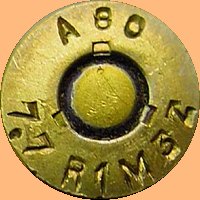 A (Armscore)
A (Armscore)
Pretoria West Metal Pressings Pty. SA... B7756R. The photo of the 7.7 R1M3Z case head was sent
by Michael Douglas.
A or AI
Artillerie Inrichtingen, Hembrug, Netherlands.
Became Nederland Wapen & Munitiefabrik'de Kruithoorn' NV,'s Hertogenbosch
Later became Eurometaal. BNC, BLK, BBLK, LTBLK, TR.
AE
Arsenal do Ejercito, Lisbon, Portugal... B7756MNC.
AOC
Bombrini, Parodi et Delfino, Rome, Italy. Used on military .303 carts
supplied to Egypt in the period 1948 - 1954... BNC, MK7NC, TR.
|
APX
Atelier de Construction de Puteaux, France. Manufactured during 1918... BNC, APNC,TR.
The 1931 round may not be crimped at all, yet the 1918 round has a very heavy crimp.
|
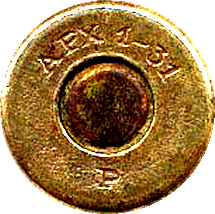
| |
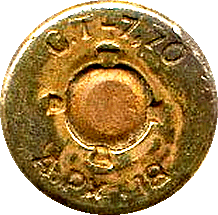
|
|---|
A - VE
Atelier de Construction de Valence, France... B.
A.VIS
Atelier de Fabrication de Vincinnes, France... B.
B,J,M or N
Birmingham Metal and Munitions Co Ltd. Birmingham, UK.
Company formed in 1897, a wholly owned subsidiary of Nobels explosive
company who also owned a further Ammunition plant, fully acquired in
1907, at Waltham Abbey, Essex. BM&M had ceased Ammunition
manufacture by 1920. The company was taken over in 1918 by
Explosives Trades Ltd which became Nobel Industries,
which was in turn was to become part of the new giant Imperial
Chemical Industries Ltd when it was formed in 1926.
The headstamp code B denoting the manufacturer should not be confused with B as
in BVIIZ which indicates incendiary Ammunition.
Types produced
between 1897 & 1919... APMKVII.P, APMKVII.W, APMKVII.W.Z, BBPMK2,
BCMK2, BCMK4, BCMK5, BCMK6, BCMK7, BNCMK7Z, BSRP, BLKBPMK3, BBLKMK6,
CRGBHMK1, D, DMK3, DMK6, DMK6D, DPMK6, EPSAMK2, EAPA, IBIKMK1.
BE or BE??
Royal Ordnance Factory, Blackpole, Worcester, UK. This
factory was part of the 1939 - 1945 war emergency expansion plan and was
situated at Blackpole on the site of the earlier Government Cartridge Factory No
3 of 1916. Initially ICI Ltd were to have operated this plant but they were
advised in 1940 of the change in plans and the factory was run as a Royal
Ordnance Factory by the Ministry of Supply. This factory made and marked cases
but filling was carried out at the Royal Ordnance Factory Swynnerton, Staffs.
cartridges produced with the BE cases from 1941 to 1945 were...
BCMK7, CRGBHMK1Z, DUMK5, IBMK6Z, IBMK7Z, TRGMK2, TRGMK3, TRGMK4.
BLANCH
J Blanch & Sons of Fenchurch St, London, UK. Made dummy drill
rounds with a one piece tinplate case and bullet, having a crimped on base, in
1915.
BM
British Munitions Co Ltd, Millwall, London, UK.
Believed to have manufactured... BBPMK2 from 1890.
BPD
Bombrini, Parodi et Delfino, Rome Italy. In addition to the .303 cartridges
manufactured for Egypt this company also manufactured nitro-cellulose loaded 7.7
x 56R cartridges, which are interchangeable with the .303 round and are known to
have been made in... B7756R, D7756R, IAPT7756R, IAPP7756R, TR7756R.
|
BROWNING
Browning Arms Co. Manufacture thought to
have been by Fabrique Nationale (National Weapons Factory) at Herstal in Belgium.
The bullet in the illustrated round was 180 gr, PSP type, Photo provided by Sylvain Benoit.
| |
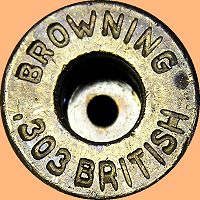
|
|---|
C..
Pirotecnico di Capua, Italy. Manufactured 7.7 x 56R bulleted blanks that are interchangeable with the .303 British.
CAC
Colonial Ammunition Co., Auckland, New Zealand. Produced .303
cartridges in... BCMK2, BCMK4, BCMK6, BCMK7, B (Mk 6 Match),BNCMK7Z,CRGBHMK1Z,BLK (Mk 6 and 6 converted), BLK (Mks 3, 5, 5z), BLK (Commercial), D (D Mk 9), Dummy (Mks 3, 4), Dummy (Non Regulation), Practice (Gaudet), Practice (short range... NZ pattern), 215 gr RNSP, 180 gr PSP, 180 gr HP, 174 gr PSP, 150 gr PSP, 130 gr PSP and 150 gr HP Sporting Ammunition, Mks 4 and 5 (Big Game Exploder) Sporting Ammunition, H.V. (Exploder) Sporting Ammunition.
CAC
Colonial Ammunition Co., Melbourne, Australia. Known to have produced during
1920-21 the .303 cartridges in... BCMK7, Dummy.
CP
Crompton Parkinson Ltd, Guiseley, Yorkshire, UK, although filling
took place at Doncaster (see below). This factory set up as part of the 1939-1945 war emergency expansion plan. Produced .303 cartridges during the period 1940 - 1944 in:- AP (W Mk 1), BCMK7.
C-P
Crompton Parkinson Ltd, Doncaster, Yorkshire, UK.
Production of Ammunition ceased in 1944. Known to have produced .303 cartridges in...
AP W Mk, AP W Mk 1 Special, EAPA (1942), BCMK7
D
Dominion Cartridge Co., Brownsburg, Quebec, Canada are
known to have produced .303 ball cartridges.
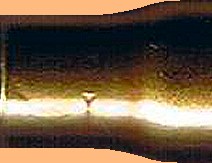
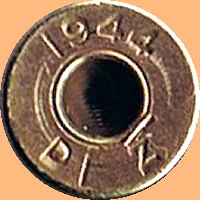 D|, DF, N| or S|
D|, DF, N| or S|
Indian Government Ammunition Factory, Dum Dum, Calcutta, India. This factory manufactured cartridges for use by the British Army
in India as well as the Indian Army. In 1918 this factory was capable of producing at
the rate of about 10 million rounds per month. The example at right is of their manufacture.
The far right image shows the unusual neck crimp consisting of three parts of the circumference
of a circle and three small triangular indents.
They produced .303 cartridges in... BCMK2,
BCMK2 Special, BCMK6 and BCMK7, BSRP I.P. Mk 1*, BLK, Dummy Drill Mk 1. IP,and IP No 2 Mk 1
DA
Dominion Arsenal, Montreal, Canada made .303 cartridges in... Ball, Cordite Mk 6
Blank, Nitro-cellulose L Canadian Mk 1 (1955 & 1956)
conversion done to here
|
DAC
Dominion Arsenal, Quebec, Canada manufactured .303 cartridges in...
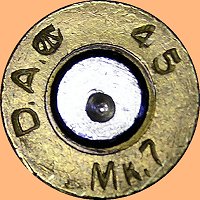 AP (W Mk 1), BCMK6, BCMK7,
Ball, Match
AP (W Mk 1), BCMK6, BCMK7,
Ball, Match
Ball, Nitro-cellulose Mk 7Z (Late Pattern)
Blank, Cordite Mk 5 (Canadian Pattern)
Blank, Nitro-cellulose L Mk 5Z (Canadian Pattern)
Drill, D Mk 6 and D Mk 9
Drill D 1942 (Canadian Pattern)
Incendiary, B Mk 7
Proof, Q Mk 4
Tracer G Mk 1 (Canadian Pattern)
Tracer G Mk 1Z (Canadian Pattern)
The 1939 DAC Mk VII is a match grade (turquoise bands) made for the Dominion
Rifle Association (the Canadian equivalent to NRA) clubs and was intended for target
shooting. Further images are avialable on the supplementary page
| |
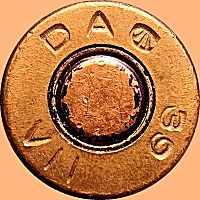
Image courtesy
Sylvain Benoit
|
|---|
DAL or LAC
Dominion Arsenal, Lindsay, Ontario, Canada. Produced .303 cartridges in... BCMK7.
DC
Defence Industries, Brownsburg, Quebec, Canada made .303 cartridges in...
Gallery Practice Mk 1 (Black powder - Canada)
Gallery Practice Mk 1 (Smokeless - Canada)
Gallery Practice Mk 2 (Canada)
DC
Dominion Cartridge Company, military production
was a simple D with a C-broad arrow for the Brownsburg plant which later became the
Dominion Ammunition Division of Canadian Industries Ltd. They operated factories in
Brownsburg, Quebec and Montreal, and the illistration is a sporting cartridge. The
DOMINION headstamp was used on commercial ammunition from 1911 untikl 1955. They
also produced .303 cartridges in... Ball, Cordite Mk 2, 4, 6 and 7
Ball, Nitro-cellulose Mk 7 (Canadian WW1 contract pattern) 1914-16
Ball, Nitro-cellulose Mk 7Z (Canadian Pattern)
Drill D 1942 (Canadian Pattern)
Tracer G Mk 2Z, G Mk 4Z (Canadian Pattern)
DCC
Dominion Cartridge Company, Montreal plant, dates and types unknown
DI
Defence Industries, Verdun, Canada. Known to have produced .303 cartridges in... Ball, Nitro-cellulose Mk 7Z (Canadian Pattern)
Ball, Nitro-cellulose Mk 8Z (Canadian Pattern)
Cartridge Rifle Grenade, Ballistite H Mk 1Z (Canadian Pattern)
Drill D 1942 (Canadian Pattern)
Tracer G Mk 2Z, G Mk 4Z, G Mk 6Z (Canadian Pattern)
Do
Hirtenberg Patronenfabrik factory at Dordrecht, Netherlands produced .303 ball cartridges.
 DOMINION
DOMINION
Made by CIL (Canadian Industries Limited) in Quebec between 1911 and 1955. They later switched to the headstamp "Imperial" (listed below), image from Michael Douglas.
DWM
Deutsche Waffen Und Munitionsfabrik, Karlsruhe, Germany produced both ball and blank .303 cartridges.
E or EB
Eley Brothers, Edmonton, London, UK. Factory in operation 1828 - 1919. During WW1 Eley produced in excess of 209 Million .303 Mk 7 cartridges. Eley Brothers produced cartridges in... Armour Piercing Mk VII.W
Ball, Cordite Mks 1, 2, 4, 6 and 7
Ball, Nitro-cellulose Mk 7Z
Ball, Short Range Practice (Gaudet)
Cartridge Rifle Grenade, Ballistite Mk 1
Cartridge Rifle Grenade, Ballistite H Mk 1Z
Drill, Mk 3, Drill Mk 3 Expedient
Explosive Pomeroy Mk 1, PSA Mk 1, PSA (VII.A) MK 1
PSA Mk 2 and PSA (VII.AA) Mk 2
Incendiary BIK (VII.K) Mk 1
RL Tracer Mk 1, Tracer SPK Mk VII.T and SPG (VII.G) Mk 1Z
E (reversed) or unstamped
Yokosuka Naval Arsenal, Japan. Fabricated nitro-cellulose loaded Imperial Japanese Navy Year Type 92 Machine Gun Ammunition, which is
interchangeable with the .303 cartridge in... Armour Piercing,
Ball, Incendiary- [Phosphorus filling] & Tracer
F or AF or SAAF
Small Arms Ammunition Factory, Footscray, Melbourne, Australia.
Known to have produced .303 cartridges in... Ball, Cordite Mk 7
Cartridge Rifle Grenade, Ballistite H Mk 1Z
Drill, D Mk 6
FC
Federal Cartridge Co, Anoka, Minn., USA. Known to have
produced nitro-cellulose loaded .303 jacketed soft point sporting Ammunition with 180 gr and
150 gr bullets.
Fiocchi
Exported MkVII type Ammunition in the 1950s from Italy.
FN
Fabrique National d'Armes de Guerre, Herstal, Belgium produced nitro-cellulose loaded .303 cartridges in... Ball, FN 8/7
Blank
Bulleted Blank
Cartridge Rifle Grenade, H Mk 7Z, M11 and M12
Incendiary
Tracer L83
Jacketed soft point sporting Ammunition
FNB
Fabrique Nationale Herstal, Herstal, Belgium
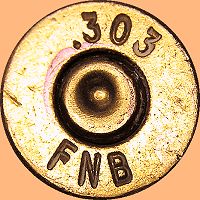 This FNB headstamp round was equipped with a 174 gr, Mk VII bullet.
This FNB headstamp round was equipped with a 174 gr, Mk VII bullet.
FNM
Fabrica Nacional de Municoes e Armas Legeiras, Moscavide, Portugal. Known to
have produced nitro-cellulose loaded 7.7 x 56R ball Ammunition which is
interchangeable with the .303 cartridges
FNT
Fabrica Nacional de Espana, Palencia, Spain. Made .303
cartridges in... Ball Mk 7Z.
G, GB or GBF
Greenwood and Batley, Leeds, UK. This company
manufactured Ammunition from an early stage, finally ceasing production in the
late 1950s. They had a filling factory at Abbey Wood and later during the
1939-45 war a filling factory at Farnham.
The headstamp code G, denoting manufacturer, should not be confused with G as in
GIV indicating a tracer cartridge. During WW1 Greenwood & Batley are known to
have produced in excess of 705 million .303 Mk 7 cartridges. They are known to
have manufactured .303 cartridges in... Ball, Black powder Mk 2
Ball, Cordite Mks 2, 4, 5, 6 and 7
Ball, Match
Ball, Nitro-cellulose Mk 7Z
Bulleted Blank Mk 6
Drill, D Mk 6, D Mk 9
Dummy, Drill Mk 5
Proof OSP
GA
Grenfell and Accles Ltd, Perry Barr, Birmingham, UK. The company
was formed in the early 1890s having acquired the Holford Works of the National
Arms and Ammunition Company and was in existence for only a short time. Known to
have manufactured Black powder Ball Mk 2 .303 cartridges from 1891 - 1896.
G18F1 or C18F1
Government Cartridge Factory No 1, Blackheath, Staffs., UK. This factory was built in 1916 and was administered on behalf of the Government by the Birmingham Metal and Munitions Co. .303 cartridge production started in early 1918 and continued until late 1918 when the factory ceased
production altogether. Type in production... BNCMK7Z.
G..F3 or C..F3
Government Cartridge Factory No 3, Blackpole, Worcestershire, UK. This factory was built in 1916 and was administered on behalf of the Government by the Kings Norton Metal Co. Production of .303 cartridges did not start until late 1918 and the production of all Ammunition ceased in early 1919. Known to have manufactured .303 cartridges in... Ball, Nitro-cellulose Mk 7Z and SPG Tracer (VIII G)
GKB or K
George Kynoch, Birmingham, UK. This company was first formed in 1862 and manufactured percussion caps. It became G. Kynoch & Co Ltd in 1884 and by then was manufacturing metallic Ammunition. It became Kynoch Ltd in 1897. Prior to the formation of Kynoch Ltd (see Kynoch) it produced .303 cartridges in... Ball, Black powder Mks 1 and 2.
GEVELOT
Gevelot & Gaupillat Freres, Paris, France. produced .303 ball cartridges for export.
Hornady
Hornady manufactured their Custom brand of nitro-cellulose loaded .303 Ammunition in the following sporting cartridges... 150 gr Spire Point Soft nosed and 174 gr Round Soft nosed.
HN
Royal Ordnance Factory, Hirwaun, South Wales, UK. This factory was set up as part of the 1939-45 war emergency expansion plan. It was involved in the production of .303 cartridges in only a very limited way and is known to have manufactured Tracer G Mk 2 (in cases dated 1943 and 1944).
|
HXP
Greek Powder and Cartridge Co, Athens, Greece made nitro-cellulose loaded .303 cartridges in... Ball, L1A1 to British Government contract(1982-85)
Ball (1969)
Blank
label details Photo... Fred Schwaner
| |
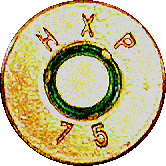
|
|---|
|
IMPERIAL
Canadian Industries Ltd, Montreal, Canada and Plattsburg, NY, USA. Produced nitro-cellulose loaded .303 sporting Ammunition in 180 gr jacketed soft point. The imperial headstamp is from was used in the 1955 - 1976 era.
Photo at right synthesized from an original by Sylvain Benoit.
| |

|
|---|
 INTERARMCO
INTERARMCO
Thought to have been manufactured by Fabrique Nationale Herstal, Herstal, Belgium for Interarmco of Virginia, USA. Picture Michael Douglas.
K or KYNOCH
Kynoch & Co, Witton, Birmingham, UK. This firm was first formed by George Kynoch at Witton in 1862 as a manufacturer of percussion caps.
It was changed to a limited company in 1884 as G. Kynoch & Co Ltd and by then
was manufacturing metallic Ammunition. A further reorganisation and expansion followed in 1889 when George Kynoch was ousted from the management and this then culminated in a further change of title to Kynoch Ltd in 1897. During the period ending with the 1914-18 war Kynoch, which by then was the largest of the British commercial Ammunition manufacturers, owned rolling mills at Witton, at Lodge
Road, Birmingham and at Eyre Street, Birmingham. At various times it had propellant factories at Arklow, County Durham, making cordite, at Warsboro Dale, Yorkshire, making black powder and at Kynochtown, Stanford Le Hope, Essex, making smokeless powder. In addition to these plants the original cap production was maintained at Witton. Later, effective tracer and incendiary composition
operations were also carried out at Witton. After the war in 1918 Kynoch Ltd, in common with most other British small arms Ammunition manufacturers, was merged into Explosives Trades Ltd, later to become Nobel Industries. In 1926 when Nobel Industries became part of the new Imperial Chemical Industries, the old Kynoch factory at Witton was retained as the Ammunition centre as part of the Metal Group within ICI. The propellant interests being concentrated mainly at Ardeer within the Nobel Division of ICI. In 1962 the Metals Division of ICI was reorganised as a separate company known as Imperial Metal Industries (Kynoch) Ltd. During WW1 Kynoch produced in excess of 2,373 million .303
cartridges.
The following .303 cartridges were produced by Kynoch...
Armour Piercing Mks VII.S, VII.P, VII.W, W Mk 1 and W Mk 1Z
Ball, Blackpowder Mk 2
Ball, Cordite Mks 2, 4, 5, 6 and 7
Ball, Match
Ball, Nitro-cellulose Mks 7Z and 8Z
Ball, Short Range Practice
Ball, Nitro-cellulose Mk 8z with Aluminium Case
Blank, Ballistite L Mk 9Z
Blank, Black powder Mk 2
Blank, Cordite Mks 4 and 5
Blank, Nitro-cellulose L Mk 5Z
Bulleted Blank, Black powder Mk 1
Bulleted Blank, Mk 6
Bulleted Blank, L Mk 7
Bulleted Blank, L Mk 10
Cartridge Line Thrower H Mk 2
Cartridge Rifle Grenade, Ballistite H Mk 1Z
Drill, D Mk 6, D Mk 8, D Mk 9 and D Mk 10
Dummy, Drill Mk 4
Greener Triplex Cartridge
Incendiary Buckingham Mk VII.B
Incendiary B Mk 3, B Mk 4Z*, B Mk 6, B Mk 6Z,
B Mk 7 and B Mk 7Z
Practice Tracer PG Mk 1
Proof Q Mk 3
Tracer, Self Destroying
Tracer Mk VII.G, G Mk 1, G Mk 2, G Mk 2Z, G Mk 3,
Tracer G Mk 3Z, G Mk 4, G Mk 5, G Mk 6, G Mk 6Z,
G Mk 7, G Mk 8 and G Mk 8Z
Triple Ball Experimental (1918) See... Pawnbroker special
180 gr Jacketed soft point sporting Ammunition
Streamlined Pattern 1927 Match Cartridge
Streamlined Pattern 1936-37 Match Cartridge
Streamlined Pattern 1947 Match Cartridge
Bulleted blanks for Bren, Lewis and Vickers
French Drill Cartridge
Experimental armour piercing
Experimental semi-armour piercing
Experimental armour piercing tracer
Experimental armour piercing incendiary (1956)
Experimental tank piercing (1940)
Experimental Tracers
Experimental Observation
Experimental Bulleted Blanks
K2
Imperial Chemical Industries Kynoch factory at Standish, near Wigan, Lancs, UK. This factory was set up as part of the 1939-45 war emergency plans and produced its first complete .303 rounds in October 1940. Known to have manufactured .303 cartridges in... Armour Piercing, W Mk 1 Special
Ball, Cordite Mk 7
Shot Cartridge
Tracer G Mk 2, G Mk 3and G Mk 6
K4
Imperial Chemical Industries Kynoch factory at Yeading, Hayes, Middlesex, UK. This factory was also set up as part of the 1939-45 war emergency expansion plans. Cartridge cases were being produced by late 1940, but the ball bullets were still being imported into the factory in 1941.This factory produced... Ball, Cordite Mk 7
Tracer G Mk 2,G Mk 3, G Mk 4, G Mk 5 and G Mk 6
K5
Imperial Chemical Industries Kynoch factory at Kidderminster, Worcestershire., UK. Set up as part of the 1939-45 war emergency expansion plans. Known to have produced .303 cartridges in... Armour Piercing, W Mk 1
Ball, Cordite Mk 7
Incendiary B Mk 7Z
Tracer, G Mk 2, G Mk 3 and G Mk 6
KF or K
Indian Government Ammunition Factory Kirkee (or Kirkee Arsenal), near Poona, INDIA. In 1918 this factory had the capacity to produce about 5.4 million rounds per month.
They manufactured .303 cartridges in... Armour Piercing W Mk 1 and W Mk 1 IP
Ball, Cordite Mk 2, Mk 2 Special, Mk 6 and Mk 7
Ball SB Mk 1
Blank
Cartridge Rifle Grenade, Cordite H Mk 3 and H Mk 5
Drill, D Mk 6 and D Mk 7
Lachrymatory Cartridge
Observation O Mk 2 and O Mk 3
Tracer G Mk 1 and G Mk 2
KN
Kings Norton Metal Co., Birmingham, UK. This company was formed
in 1890 at Kings Norton, it owned its own rolling mills and had a loading plant
at Abbey wood in Kent. Cases were made in Birmingham then assembled and loaded
at the Abbey Wood Factory, next to Woolwich Arsenal.
Produced .303 cartridges up to 1919 in...
Armour Piercing VII.F, VII.FZ and VII.W
Ball, Cordite Mks 2, 4, 5, 6, 7
Ball, Match
Ball, Nitro-cellulose Mk 7Z
Blank Cordite Mk 5
Bulleted Blank Mk 6
Dummy, Drill Mk 3, Mk 3 Expedient, Mk 5
Explosive RTS (VII.R) Mk 2
Incendiary BIK (VII.K) Mk 1
Incendiary Buckingham (VII.B) and B Mk 3
Tracer SPG Mk VIIG Mk 1 and Mk 1Z
Experimental RTT Explosive Cartridge
Experimental Blank Cartridges
L
There is some confusion over this headstamp code as both Lorenz Ammunition and
Ordnance Co, Millwall, London, UK and Ludlow and Co, Wolverhampton,
Staffs, UK are believed to have used the letter L as their code and both
manufactured .303 cartridges between 1887 and 1890. Both firms are believed to
have manufactured .303 Black powder Mk 2 Ball Cartridges
L-E or U
Remington UMC, Bridgeport, Conn., USA. {On UK
Government contracts 1914 - 1915}. manufactured nitro-cellulose
loaded .303 Ball, Mk 7 cartridges
M
Nobel Explosives Ltd., Manchester, UK. Manufactured .303
cartridges between 1914 - 1918 in...
Ball, Cordite Mk 7 and Explosive, PSA Mk 2
MAXIM
Maxim Arms Co.,London, UK. The cases were made by BSA for
Maxim machine guns in the 1890s. Cartridges known to have been manufactured in:
Ball, Cordite Mk 2
MEN
Maschinenfabrik Elisenhutte, Nassau, West Germany.
This producer has now become
Metallwerk Elisenhütte GmbH Nassau. This company produced
.303 ball cartridges during 1988 [Harrington website].
MEXICO
Fabrica National de Munitions, Mexico City, Mexico produced .303 ball cartridges.
MF or AÎF
Small Arms Ammunition Factory No 1, Footscray, Melbourne, Australia.
manufactured .303 cartridges in... Armour Piercing W Mk 1
Ball, Cordite Mk 7
Blank, Cordite L Mk 5
Blank, Mk 9Z
Cartridge Rifle Grenade, Cordite H Mk 4
Drill, D M 7/N
Incendiary B Mk 7
Proof Q Mk 3 and Q Mk 4
Tracer G Mk 2 {Australian Pattern}
MG
Small Arms Ammunition Factory No 2, Footscray, Melbourne, Australia. 1940 -
1949. Known to have manufactured .303 cartridges in... Ball, Cordite Mk 7 and Incendiary B Mk 7.
MH
Small Arms Ammunition Factory No 3, Hendon, Australia. Known to have produced
.303 cartridges in... Ball, Cordite Mk 7
Blank, Cordite L Mk 5
Tracer G Mk 2 {Australian Pattern}
Incendiary B Mk 7
MI
Societe Meridionale d'Industrie, Robert Paulet & Cie, formerly called
Cartoucherie Leon Paulet, Marseille, France made 7.7 x 56R ball cartridges.
MJ
Small Arms Ammunition Factory No 4, Hendon, Australia produced .303 cartridges in... BCMK7.
MKE
Makina ve Kimya Endustrisi, Kuruma, Turkey manufactured 7.7 x 56R ball cartridges.
MQ
Small Arms Ammunition Factory No 5, Rocklea, Australia... made .303 BCMK7.
MS
Small Arms Ammunition Factory No 7, Salisbury, Australia... made .303 BCMK7 and TRGMK2Z {Australian pattern}.
MW
Small Arms Ammunition Factory No 6, Welchpool, Australia.
nny See PP
NORMA or norma
Norma Projectilfabrik, Amotfors, Sweden produced nitro-cellulose loaded .303 cartridges in... BBLK, 130gr, 150gr, 180gr and 215 gr jacketed soft point sporting rounds.
OFN
Government Ordinance Factory, Lagos, Nigeria produced .303 ball cartridges.
P or PC
Peters Cartridge Co., Kings Mills, Ohio, USA. Produced nitro-cellulose loaded .303 cartridges in... Ball, Mk 7. British military contracts between 1914 & 1917,
Ball, Mk 7Z (Canadian Pattern). On British military contracts 1940-45 180 & 215
gr jacketed soft point sporting Ammunition
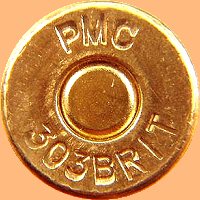 PMC
PMC
Suggestions as to what PMC stands for are 'Precision Made
Cases' or 'Precision Metallic Cartridge', but I now know it is 'Precision Made Cartridge' here
is a link to their website. I picked
up the illustration at right from www.Ammo-one.com
and would comment that the head stamping is hardly what I would call 'precision'. I think it
unlikely that it is 'Poongsan Metal Manufacturing Company' Ltd., Seoul, Republic of Korea
Angang Ammunition Plant. As the 'M' is not shaped like an upside 'W'. Eldorado Cartridge
Corporation (was Patton and Morgan Corp., and Pan Metal Corp.) PO Box 62508, Boulder City,
NV 89006. The PMC head stamped Ammunition for ECC has been made in Korea, the Philippines,
Mexico and the Republic of South Africa. I am also told that PMC originally stood for
"Pan Metallic Corporation" and they were initially made in Korea.
PMP
Pretoria Metal Pressings (Pty) Ltd., Pretoria, South Africa made nitro-cellulose filled .303 cartridges in... 174 gr Full jacket boat tail bulleted Ammunition
150 and 174 gr jacketed soft point sporting Ammunition.
POF
Pakistan Ordnance Factory, Rawalpindi, Pakistan.
Known to have produced .303 cartridges in... B, BLK, GLB, Proof (Mk 3).
| |
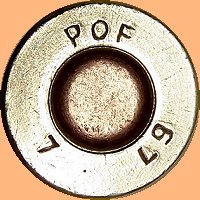
|
|---|
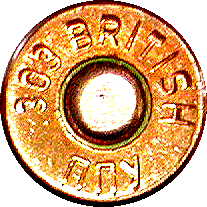 PP or nny
PP or nny
Prvi Partizan, Titovo Uzice, Yugoslavia. (Yugoslav arsenal code PPU, which
in Cyrillic looks like 'nny'.) Their latest address is... Prvi Partizan, Milosa Obrenovica 2,
31000 Uzice, SERBIA AND MONTENEGRO, Phone: +381 31 511 382, Fax: +318 31 515 350 Email:
office@prvipartizan.com The Prvi
Partizan company was founded in 1928. In those days it was operating under the name FOMU
- Arms and Ammunition Factory Uzice involved in shotgun Ammunition manufacture. The factory
had developed pistol and revolver Ammunition production by the year 1938. This factory has
produced .303 cartridges in... Ball, Mk 7, 7Z , 8 and 8Z and various sporting loads. Since the
break up of Yugoslavia the factory is in Serbia and Ammunition is sold in boxes that have
the Wolf brand... Information from Michael Douglas who also took the box Photos.
Photo... Fred Schwaner
PS or S
Pirotechnico Militar de Seville, Spain made 7.7 x 56R
cartridges which are interchangeable with the .303 cartridge in... Ball and Tracer (Green tip).
RA
Remington Arms Co.,Inc., Bridgeport, Conn., USA. Nitro-cellulose filled .303 WW1 Contract Pattern cartridges were produced during the period 1914 - 1917 as.
Ball, Mk 7.
RA
Raufoss Ammunisjonsfabrikker, Raufoss, Norway produced .303 ball cartridges c 1934
REM-UMC
Remington-Union Metallic Cartridge 1911-1960,
then became R-P (Remington Peters) view packet .
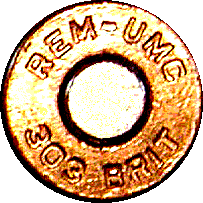
RG
Royal Ordnance Factory, Radway Green, Cheshire, UK. This factory
was part of the 1939 - 45 war emergency expansion plans being situated near Crewe
and is still in operation. Production of the .303 cartridge commenced in 1940
and the last known production of this cartridge was in 1973 with Mk 7Z Ball and
Dummy Drill cartridges. Initial Radway Green production used a single arrow as
the headstamp code and this was replaced in 1942 by the RG code.
Armour Piercing W Mk 1, W Mk 1 Special and W Mk 1Z
Ball, Cordite Mk 7
Ball, Nitro-cellulose Mks 7Z and 8Z
Blank, Ballistite L Mk 9Z
Blank, Cordite L Mk 5
Blank, Nitro-cellulose L Mk 5Z
Bulleted Blank, Nitro-cellulose L Mk 10Z
Cartridge Rifle Grenade, Cordite H Mk 2, H Mk 4 and H Mk 4Z
Drill, D Mk 10
Dummy Drill 1973 Pattern
Dummy, U Mk 5
Incendiary B Mk 6, B Mk 6Z, B Mk 7 and B Mk 7Z
Proof, Q Mk 3
Tracer G Mk 2 and G Mk 8
RH
Raleigh Cycle Co, Nottingham, UK. Made BCMK7... 1941 - 1945.
RL
Royal Laboratory, Woolwich Arsenal, Kent, UK. Woolwich Arsenal,
of which the Royal Laboratory was only a part, is situated in South East London
on the River Thames. The Arsenal dates from 1670 and has manufactured many
different items of warlike stores for the armed forces. Ammunition was made at
Woolwich long before the adoption of the .303 cartridge in 1889. Ammunition
production ceased completely at Woolwich in 1957, the last known production of
.303 Ammunition there being Mk 7 Ball in 1957.
The Woolwich site apart from containing all the supportive facilities for the
research, design, development, inspection and testing of Ammunition also
included an extensive range complex on the Plumpstead Marshes. In addition there
was a filling area not far away in the vicinity of Abbey Wood.
The following .303 cartridges are known to have been produced since 1889...
Armour Piercing Mks VII.S, VII.P, VII.PZ, VII.W, VII.WZ, W Mk 1,
W Mk 1 Special and W MK 1Z
Ball, Black powder Mks 1,and 2
Ball, Cordite Mks 1, 2, 2*, 3, 4, 5, 6 and 7
Ball, Match
Ball, Nitro-cellulose Mks 7z, 8z & 7z RC (reduced charge)
Ball, Short Range Practice, Cordite Mks 1,2,3 and 4
Ball, Short Range Practice (Gaudet)
Blank, Black powder Mks 2 and 3
Blank, Cordite, Mks 2, 3, 4, 5
Blank, Cordite L Mk 5
Bulleted Blank, Black powder Mk 1
Bulleted Blank, Cordite Mks 1, 6
Bulleted Blank, L Mk 7
Bulleted Blank, L Mk 10Z
Cartridge Rifle Grenade, Cordite Mks 1 and 2
Cartridge Rifle Grenade, Cordite H Mk 2
Cartridge Rifle Grenade, Ballistite H Mk 1Z
Cartridge Discharger, Black powder E Mk 1T
Drill, Magazine Rifle Mk 1 and 2
Drill D Mk 6, D Mk 6*, D Mk 7, D Mk 8 and D Mk 9
Dummy, U Mk 5
Dummy Drill Mks 3, 4, 5, 6
Dummy Version of Explosive R Mk 3*
Inspectors Dummy Mk 1, 2, 3, 4 and 5
Explosive R Mk 1, R Mk 2, R Mk 3, and R Mk 3*
Incendiary Buckingham (VII.B), B Mk 1, B Mk 2Z, B Mk 4,B Mk 4
B Mk 5, B Mk 6, B Mk 6Z and B Mk 7
Instructional Mk 6
Machine Gun Blank, Cordite Mk 1
Machine Gun Dummy Mks 1 and 2
Observing O Mk 1
Proof, Cordite Mk 1, Mk 2, Mk 3, Q Mk 3, Q Mk 4 and Q Mk 5
Shot Cartridges
RL Tracer Mk 1
Tracer SPK(VII.T) and SPK(VII.TZ)
Tracer SPG(VII.G) Mk 1 and SPG(VII.G) Mk1Z
Tracer G Mk 1, G Mk 1 Special, G Mk 2, G Mk 3 and G Mk 4
Experimental steel anti fouling bulleted rounds
Experimental Armour Piercing Tracer (1917-18)
Experimental Armour Piercing Cartridges
Experimental Bulleted Blanks
Experimental Explosive, RTS and RTT Cartridges
Experimental Grenade Launching Cartridges
Experimental Lachrymatory Cartridge
RNRA
Rhodesia National Rifle Association nitro-cellulose loaded .303 Mk 7z Ball manufactured by FNM of Moscavide in Portugal.
R-P
Remington Arms Co, Bridgeport, Conn., USA made nitro-cellulose loaded .303 cartridges in:- 180 & 215 gr jacketed soft point sporting forms.
RR or RRCO
Ross Rifle Co, Montreal, Canada. Produced .303 Mk 7 ball Ammunition in cases believed to have been made by Eley.
RTS
Richard Threlfall and Sons, UK... explosive anti - Zeplin cartridges.
R..W
Rudge Whitworth Ltd., Tyseley, UK. This company was the only new commercial Ammunition manufacturer put into business by the Government as a result of demand in the 1914 - 18 war. They received their first Government contract for the supply of Mk 7 Ball Ammunition in 1915 and continued to produce .303 cartridges from 1915 - 1918 in... BCMK7, DUMK5, I (Buckingham VII.B), I (B Mk 1),I (B Mk 2Z),
TR (SPG VII.G), TR (Mk 1Z).
|
S&B
Sellier & Bellot, 180 gr full metal jacket and 150 gr soft point sporting, both types boxer primed Photo of headstamp... Fred Schwaner
| |
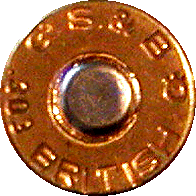
|
|---|
SBR
Sellier & Bellot, Riga, Latvia... produced .303 ball cartridges c 1937
SFM
Societe Francaise des Munitions, Issy - les - Moulineaux, France manufactured nitro-cellulose loaded .303 ball cartridges for export pre 1939.
SMI
Societa Metallurgica Italiana, Campo Tizzoro, Italy made nitro-cellulose loaded 7.7 x 56R Ammunition types B7756R and TR7756R.
SR
Royal Ordnance Factory, Spennymoor, Durham, UK. This factory was part of the 1939-45 war emergency expansion plan. It began production of .303 Ammunition in 1941 initially with the headstamp code of two arrows replacing these in 1942 with the code SR. The Spennymoor Ammunition was filled at the Royal Ordnance Factory, Aycliffe, Durham. Types... B, MK7, MK8Z, IBMK6, IBMK6Z, IBMK7, IBMK7Z,LTBLK (Mk5) were manufactured.
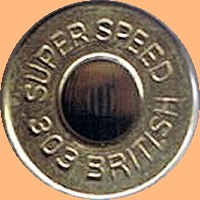 SUPER SPEED
SUPER SPEED
is a Winchester trademark, no other details as far as the .303 brass pictured here. This case picked up and scanned by Michael Douglas.
TM..B
Pirotechnia di Bologna, Italy produced nitro-cellulose loaded 7.7 x 56R Ammunition, interchangeable with the .303 in... B and TR.
THOMAS BLAND & SONS (stamp require verifying) made .303 ball and sporting Ammunition.
|
U or SAM
South African Mint, Pretoria, South Africa... U code from 1939 - 1961 and SAM 1962 onwards. (When U is used with a diamond this represents the Kimberley factory... B, BCMK7, TRGMK2, Semi AP (F Mk 1), Jacketed soft point sporting.
|
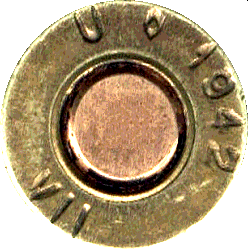
|
|---|
|
US
United States Cartridge Co, Lowell, Mass., USA made nitro-cellulose loaded .303 Ball Mk 7 cartridges during 1914 - 1917.
The finishing date has been called into question... By finds made by 'Juergen' from Magdeburg, the four headstamps illustrated at right were all found in the same cache of Ammunition that was made between WWI and WWII.
The very poor quality crimp shown at upper right is typical of worn out machinery that had been patched up to reach the end of WWII.
It might be speculated that the 'missing' primer crimp is also due to faulty machinery or broken tooling.
|
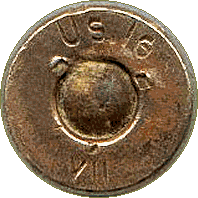

| |
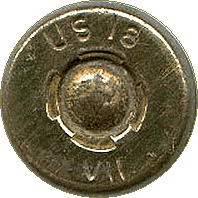
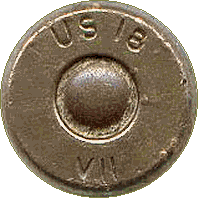
|
|---|
VE
Cartoucherie de Valence, France have produced nitro-cellulose loaded .303 Ball cartridges
VPT
Valtion Patruunatehdas, Lapua, Finland produced Ilmavoimat Konekivaarin Patruuna Kal 7.70 machine gun cartridges, which are interchangeable with the .303 cartridge in... 'Special' B, 'Special' AP.
|
 W or WRA
W or WRA
Winchester Repeating Arms Co., New Haven, Conn., USA. Known to have made nitro-cellulose loaded .303 cartridges for 1914 - 1917 military contracts as... B, and Mk 7.
During WW2... B, Mk 7Z (Contract Pattern),Scott multiball (duplex) and 180 gr jacketed soft point sporting Ammunition.
Photo... Fred Schwaner. An unusual Winchester box is shown on the
supplementary page that contains rounds with WCC headstamp.
WCC
Western Cartridge Co., East Alton, Ill., USA. Known to have produced nitro-cellulose loaded .303 cartridges in... B, Mk 7Z (WW2 Contract Pattern).
|
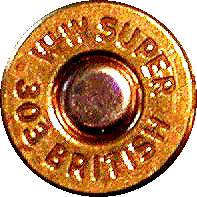 WW SUPER (W-W SUPER)
WW SUPER (W-W SUPER)
Winchester Western (unsure which factory) 180 gr 'Power Point', brass trimmed to 2.208", Boxer primed, overall length 3.055", muzzle velocity 2367 fps
Photo... Fred Schwaner
W-W
Winchester Western Division of Olin Industries, New Haven,
Conn., USA. Produced nitro-cellulose loaded .303 180 gr Jacketed soft point sporting Ammunition.
y
Toyokawa Naval Arsenal, Japan. Known to have produced nitro-cellulose loaded
Imperial Japanese Navy Year Type 92 Machine Gun Ammunition which is
interchangeable with the .303 cartridge in... AP, IP, TR, B.
ZV
Zbrojovka Brno, Brno, Czechoslovakia made .303 cartridges in... B, Mk 7, MK 8Z
CHINA made some 7.7mm rimmed Ammunition for use in captured Japanese machine guns from 1945 onwards. This cartridge is interchangeable with the .303 British cartridge.
EGYPT produced .303 ball Ammunition at the Government Arsenal Shoubra, United Arab Republic and Factory No 10 at Alexandria in Egypt.
ETHIOPA manufactured .303 ball cartridges c 1959
FINLAND is known to have produced .303 inch cartridges in various loadings
including:- B, AP, D, I, TR.
FRANCE manufactured several variants of the .303 cartridge, including:- B, TR, I, AP, AP with Tracer.


 IRAQ is known to have produced .303 Ball cartridges, but details are missing. Iraqi Stamps
often have a triangle and symbols, the leftmost two images at right were provided by Lee
Ratcliff while the rightmost one came from Jim DeMay. Note the poor centring of the primer
crimping groove. Images of carton are available on the supplementary page.
IRAQ is known to have produced .303 Ball cartridges, but details are missing. Iraqi Stamps
often have a triangle and symbols, the leftmost two images at right were provided by Lee
Ratcliff while the rightmost one came from Jim DeMay. Note the poor centring of the primer
crimping groove. Images of carton are available on the supplementary page.
ISRAEL manufactured .303 ball cartridges at the Government Arsenal, Tel Aviv, Israel. c 1948
JAPAN is known to have manufactured nitro-cellulose loaded Imperial Japanese
Army Year Type 89 Machine Gun Ammunition, which is interchangeable with the .303
cartridge, without any headstamp codes in... APNC, TR.
JAPAN is also known to have manufactured nitro-cellulose Imperial Japanese Navy
Year Type 92 Machine Gun Ammunition, which is interchangeable with the .303
cartridge, at their Aichi Naval Arsenal, Toyokawa Naval Arsenal and Yokosuka
Naval Arsenal in the following types... APNC, TR, B, HE (Violet Primer), IP.
SPAIN manufactured .303 Ammunition and used it on a limited scale during and
after the Civil War of 1936 - 39.
I have been stumped by the far right headstamp sent by Michael Douglas, which is boxer
primed and had a crimped primer.
IGMAN d.d. Konjic, Donje Polje 42, 88400 Konjic, Bosnia and Herzegovina... Produce the ammunition that has puzzled many shooters, there are two images at right, I am endebted to Erick Fisk for unravelling the mystery and further images are avialable on the supplementary page
| |
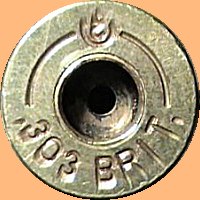
|
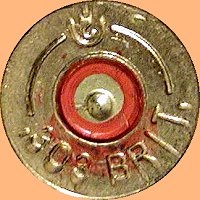
|
|---|
|
If you can identify the headstamp illustrated at right, I can include the
details here. Although not shown in this image, the case normally carries a green
annular sealer around the primer. The bullet was a hunting type, round nose
180 gr. What looks like a primer crimp is eithe cosmetic or inadequately struck,
as there was no effort at all in de-priming.
| |
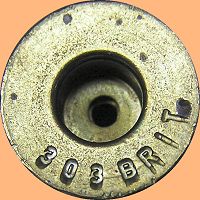
|
|---|
Various people have given help with information and images... I thank them warmly, some are mentioned in the text, but if I have ommitted anybody I appologise, A few did not wish to be identified, so I will say a little thank you to the anonymous contibutors as well.
Printed from Dave Cushman's website Live CD version
Originated... Spring 2001,
Revised... 12 July 2001,
Revised... 19 June 2002,
Revised... 07 March 2003,
Corrected... 04 September 2003,
New Domain... 12 November 2003,
Upgraded... 24 December 2004,
Addition... 18, 20 February 2006,
Further Upgraded... 18 January 2007,
Additions... 14, 16 20, & 25 April 2007,
Addition... 06 May 2007,
Addition... 11 August 2007,
Upgrade & Additions... 25 to 28 January 2008,
Code Altered... 18 May 2008,
Additions... 31 December 2008,
Source Code last updated...
|

|

|
|
|---|
|







 AP (W Mk 1), BCMK6, BCMK7,
Ball, Match
AP (W Mk 1), BCMK6, BCMK7,
Ball, Match

 This FNB headstamp round was equipped with a 174 gr, Mk VII bullet.
This FNB headstamp round was equipped with a 174 gr, Mk VII bullet.


















 IRAQ is known to have produced .303 Ball cartridges, but details are missing. Iraqi Stamps
often have a triangle and symbols, the leftmost two images at right were provided by Lee
Ratcliff while the rightmost one came from Jim DeMay. Note the poor centring of the primer
crimping groove. Images of carton are available on the
IRAQ is known to have produced .303 Ball cartridges, but details are missing. Iraqi Stamps
often have a triangle and symbols, the leftmost two images at right were provided by Lee
Ratcliff while the rightmost one came from Jim DeMay. Note the poor centring of the primer
crimping groove. Images of carton are available on the 

